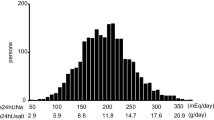Summary
Twenty-four-h urinary sodium and dopamine output by normotensive adults from 5 different ethnic groups have been measured. The groups differed substantially in the correlation between the urinary output ot sodium and dopamine. Those with a traditionally salt rich diet (Thais, Caucasians, Zimbabweans) showed a strong positive correlation (p<0.001), whereas no such relationship was found in West Africans and Iranians, who come from traditionally salt scarce environments.
It is hypothesised that in some races the lack of or uncoupling of the renal sodium-dopamine relationship, possibly as a mechanism to help conserve dietary sodium, predisposes to the development of hypertension when the individuals encounter a salt rich diet.
Similar content being viewed by others
References
Lee MR (1986) Dopamine and the kidney. In: Lote CJ (ed) Advances in renal physiology. Croom Helm, London Sydney, pp 218–246
Saito I, Takeshita E, Saruta T, Nagano S, Sekihara T (1986) Urinary dopamine excretion in normotensive subjects with or without a family history of hypertension. J Hypertens 4: 57–60
Casson IF (1984) Studies on the role of dopamine in renal failure. MD thesis, University of Leeds, pp 215–235
Stamler J, Stamler R, Reidlinger WF, Algera G, Roberts RH (1976) Hypertension screening in one million Americans. J Am Med Assoc 235: 2299–2306
Lee MR (1981) The kidney fault in essential hypertension may be a failure to mobilise renal dopamine adequately when dietary sodium chloride is increased. Cardiovasc Rev Repir 8: 785–789
Anton AH, Sayre DF (1964) The distribution of dopamine and dopa in various animals and a method for their determination in diverse biological material. J Pharmacol Exp Ther 145: 326–336
Harvey JNR (1985) Studies of urinary dopamine in essential hypertension and the effect of renal dopaminergic drugs. MD thesis, University of Leeds, pp 74–76
Cruickshank JK, Jackson SHD, Beevers DG, Bannan LT, Beevers M, Stewart VL (1985) Similarity of blood pressure in Blacks, Whites and Asians in England — The Birmingham factory study. J Hypertension 3: 365–371
Dallas Hall W (1985) The pharmacologic therapy of hypertension in Blacks. In: Hall WD, Saunders E, Shulman NB (eds) Hypertension in Blacks. Year Book Publishers, Chicago, pp 182–208
Author information
Authors and Affiliations
Rights and permissions
About this article
Cite this article
Critchley, J.A.J.H., Lee, M.R., Gordon, C.J. et al. Ethnic differences in the renal sodium-dopamine relationship: a possible explanation for regional variation in the prevalence of hypertension?. Eur J Clin Pharmacol 37, 559–562 (1989). https://doi.org/10.1007/BF00562544
Received:
Accepted:
Issue Date:
DOI: https://doi.org/10.1007/BF00562544




